Advice to Mr. Patterson Assignment
VerifiedAdded on 2021/02/19
|9
|2684
|40
AI Summary
Contribute Materials
Your contribution can guide someone’s learning journey. Share your
documents today.
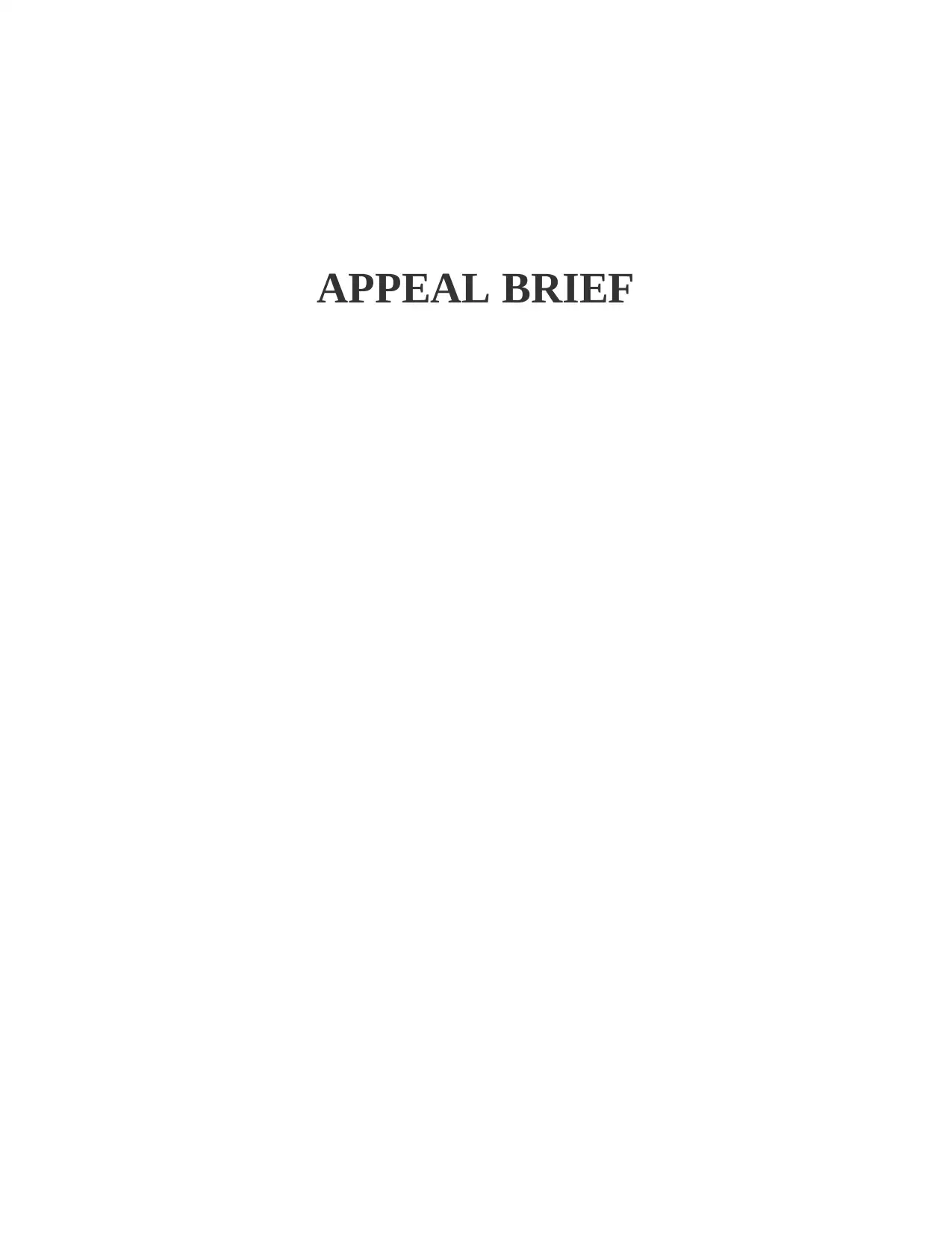
APPEAL BRIEF
Secure Best Marks with AI Grader
Need help grading? Try our AI Grader for instant feedback on your assignments.
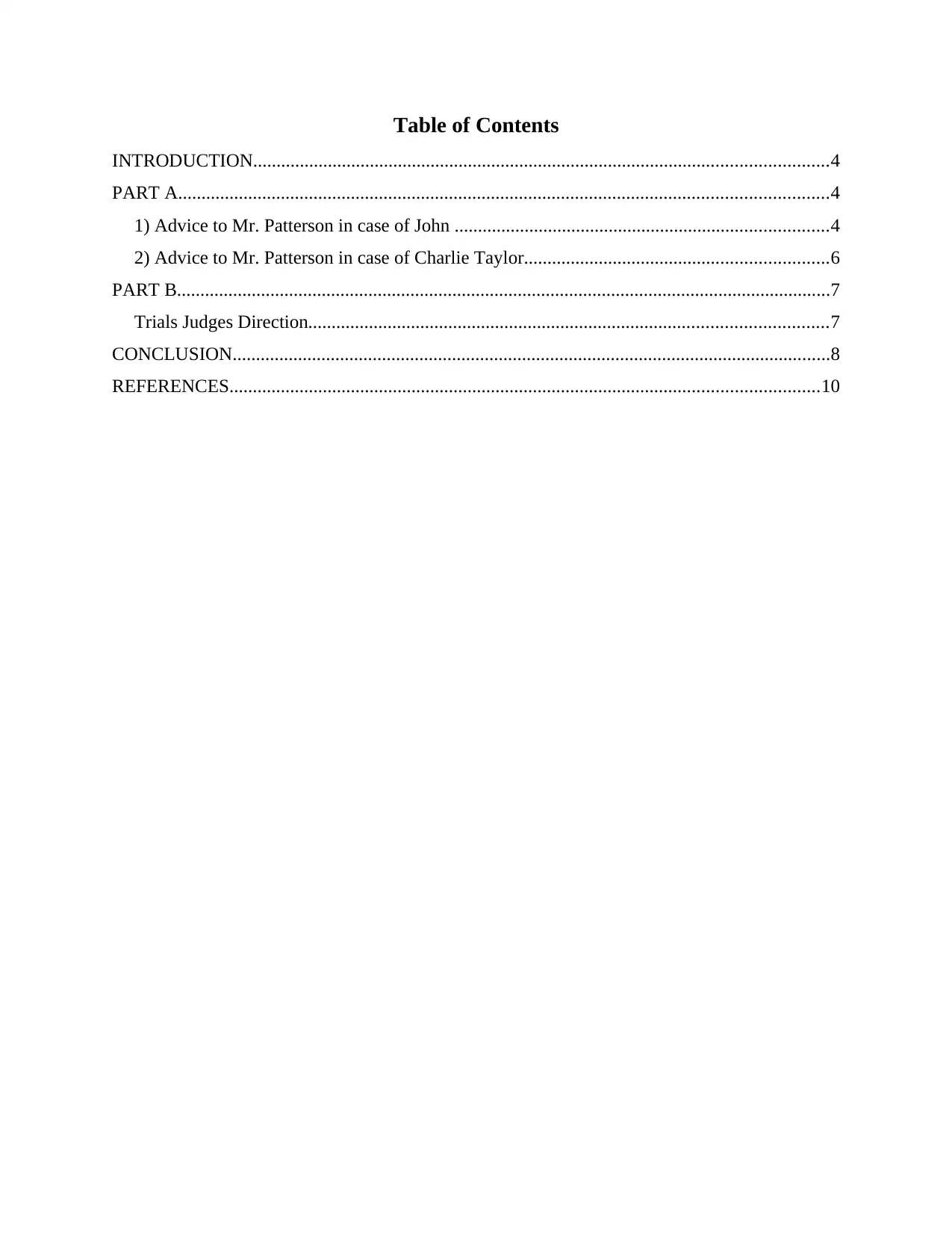
Table of Contents
INTRODUCTION...........................................................................................................................4
PART A...........................................................................................................................................4
1) Advice to Mr. Patterson in case of John ................................................................................4
2) Advice to Mr. Patterson in case of Charlie Taylor.................................................................6
PART B............................................................................................................................................7
Trials Judges Direction...............................................................................................................7
CONCLUSION................................................................................................................................8
REFERENCES..............................................................................................................................10
INTRODUCTION...........................................................................................................................4
PART A...........................................................................................................................................4
1) Advice to Mr. Patterson in case of John ................................................................................4
2) Advice to Mr. Patterson in case of Charlie Taylor.................................................................6
PART B............................................................................................................................................7
Trials Judges Direction...............................................................................................................7
CONCLUSION................................................................................................................................8
REFERENCES..............................................................................................................................10
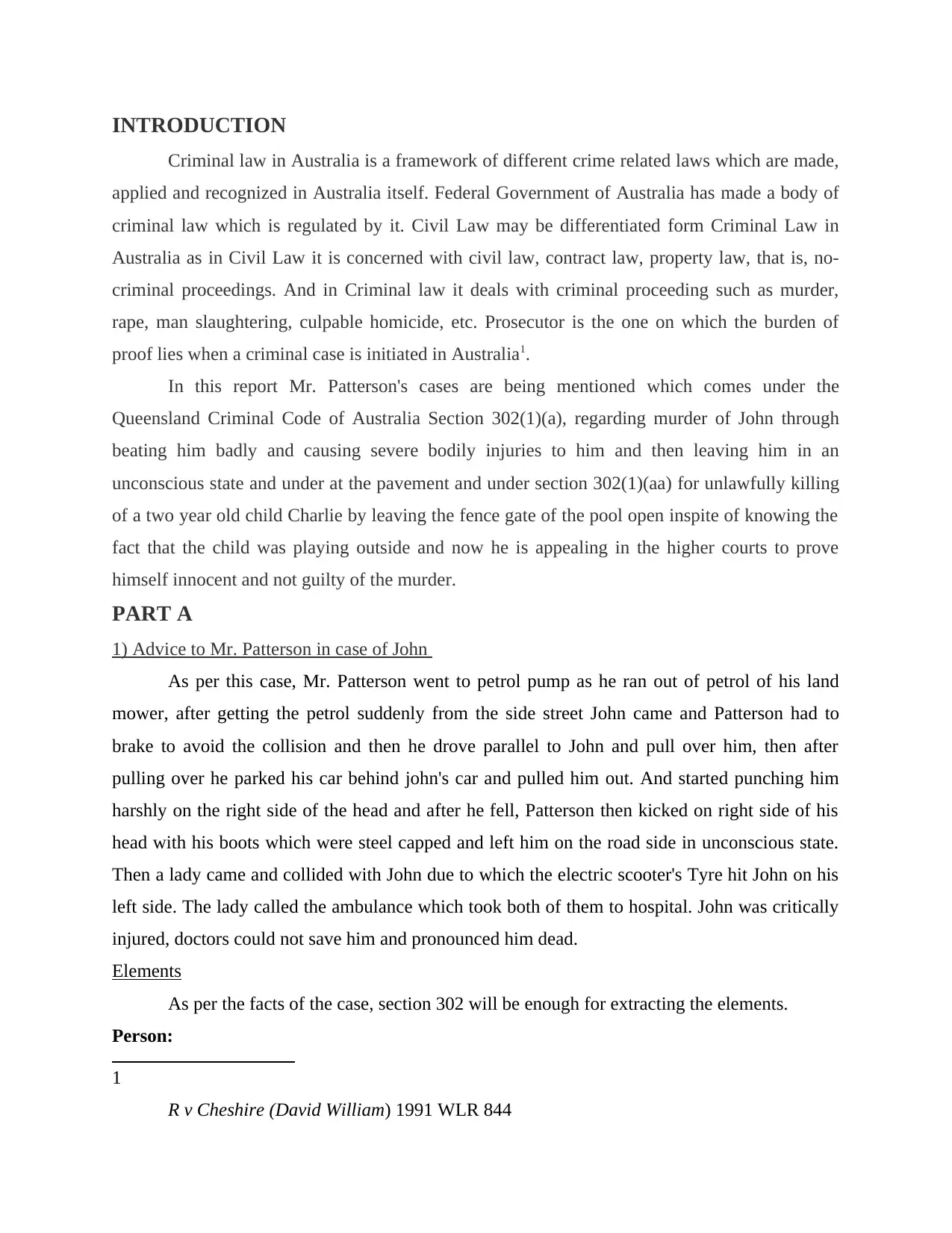
INTRODUCTION
Criminal law in Australia is a framework of different crime related laws which are made,
applied and recognized in Australia itself. Federal Government of Australia has made a body of
criminal law which is regulated by it. Civil Law may be differentiated form Criminal Law in
Australia as in Civil Law it is concerned with civil law, contract law, property law, that is, no-
criminal proceedings. And in Criminal law it deals with criminal proceeding such as murder,
rape, man slaughtering, culpable homicide, etc. Prosecutor is the one on which the burden of
proof lies when a criminal case is initiated in Australia1.
In this report Mr. Patterson's cases are being mentioned which comes under the
Queensland Criminal Code of Australia Section 302(1)(a), regarding murder of John through
beating him badly and causing severe bodily injuries to him and then leaving him in an
unconscious state and under at the pavement and under section 302(1)(aa) for unlawfully killing
of a two year old child Charlie by leaving the fence gate of the pool open inspite of knowing the
fact that the child was playing outside and now he is appealing in the higher courts to prove
himself innocent and not guilty of the murder.
PART A
1) Advice to Mr. Patterson in case of John
As per this case, Mr. Patterson went to petrol pump as he ran out of petrol of his land
mower, after getting the petrol suddenly from the side street John came and Patterson had to
brake to avoid the collision and then he drove parallel to John and pull over him, then after
pulling over he parked his car behind john's car and pulled him out. And started punching him
harshly on the right side of the head and after he fell, Patterson then kicked on right side of his
head with his boots which were steel capped and left him on the road side in unconscious state.
Then a lady came and collided with John due to which the electric scooter's Tyre hit John on his
left side. The lady called the ambulance which took both of them to hospital. John was critically
injured, doctors could not save him and pronounced him dead.
Elements
As per the facts of the case, section 302 will be enough for extracting the elements.
Person:
1
R v Cheshire (David William) 1991 WLR 844
Criminal law in Australia is a framework of different crime related laws which are made,
applied and recognized in Australia itself. Federal Government of Australia has made a body of
criminal law which is regulated by it. Civil Law may be differentiated form Criminal Law in
Australia as in Civil Law it is concerned with civil law, contract law, property law, that is, no-
criminal proceedings. And in Criminal law it deals with criminal proceeding such as murder,
rape, man slaughtering, culpable homicide, etc. Prosecutor is the one on which the burden of
proof lies when a criminal case is initiated in Australia1.
In this report Mr. Patterson's cases are being mentioned which comes under the
Queensland Criminal Code of Australia Section 302(1)(a), regarding murder of John through
beating him badly and causing severe bodily injuries to him and then leaving him in an
unconscious state and under at the pavement and under section 302(1)(aa) for unlawfully killing
of a two year old child Charlie by leaving the fence gate of the pool open inspite of knowing the
fact that the child was playing outside and now he is appealing in the higher courts to prove
himself innocent and not guilty of the murder.
PART A
1) Advice to Mr. Patterson in case of John
As per this case, Mr. Patterson went to petrol pump as he ran out of petrol of his land
mower, after getting the petrol suddenly from the side street John came and Patterson had to
brake to avoid the collision and then he drove parallel to John and pull over him, then after
pulling over he parked his car behind john's car and pulled him out. And started punching him
harshly on the right side of the head and after he fell, Patterson then kicked on right side of his
head with his boots which were steel capped and left him on the road side in unconscious state.
Then a lady came and collided with John due to which the electric scooter's Tyre hit John on his
left side. The lady called the ambulance which took both of them to hospital. John was critically
injured, doctors could not save him and pronounced him dead.
Elements
As per the facts of the case, section 302 will be enough for extracting the elements.
Person:
1
R v Cheshire (David William) 1991 WLR 844
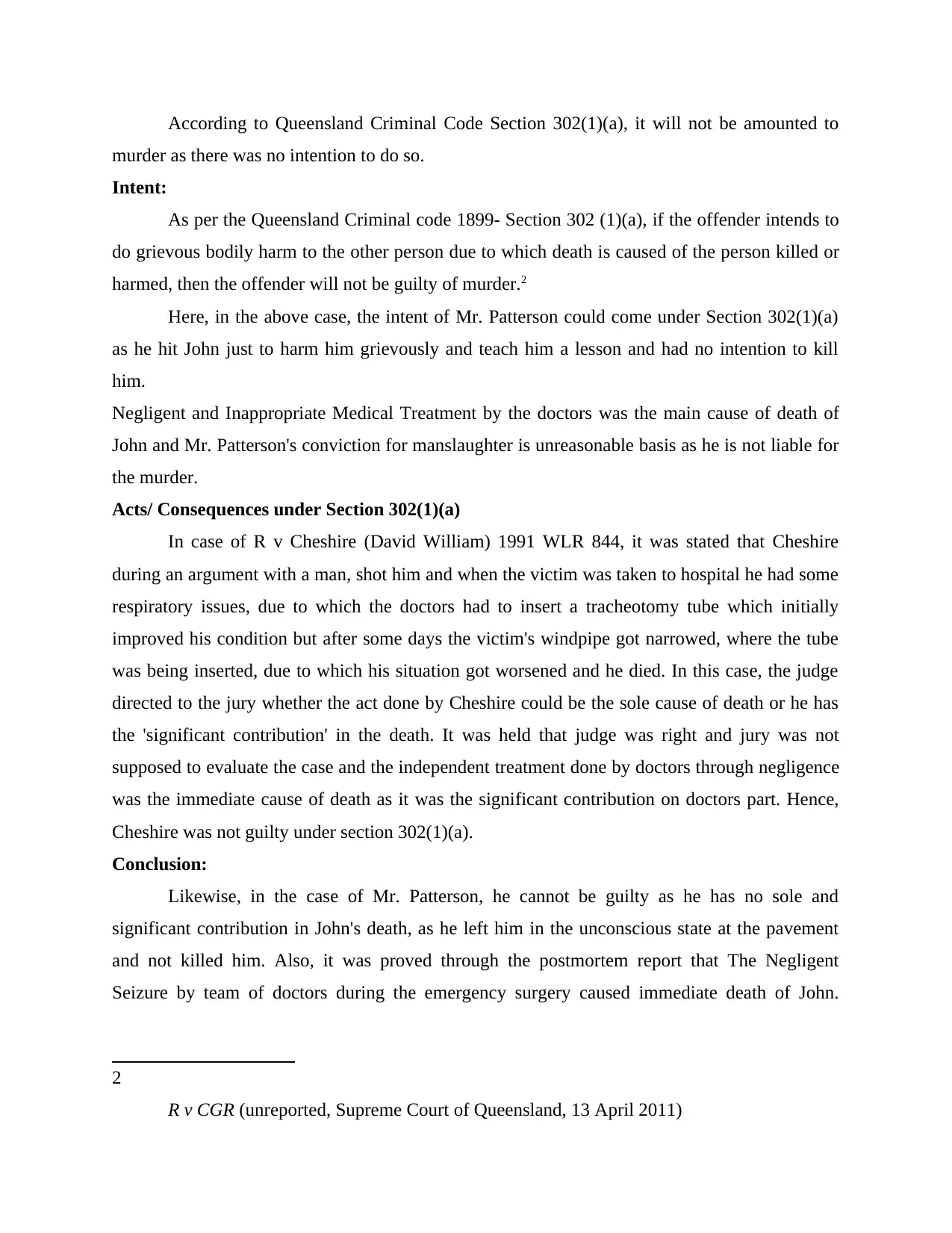
According to Queensland Criminal Code Section 302(1)(a), it will not be amounted to
murder as there was no intention to do so.
Intent:
As per the Queensland Criminal code 1899- Section 302 (1)(a), if the offender intends to
do grievous bodily harm to the other person due to which death is caused of the person killed or
harmed, then the offender will not be guilty of murder.2
Here, in the above case, the intent of Mr. Patterson could come under Section 302(1)(a)
as he hit John just to harm him grievously and teach him a lesson and had no intention to kill
him.
Negligent and Inappropriate Medical Treatment by the doctors was the main cause of death of
John and Mr. Patterson's conviction for manslaughter is unreasonable basis as he is not liable for
the murder.
Acts/ Consequences under Section 302(1)(a)
In case of R v Cheshire (David William) 1991 WLR 844, it was stated that Cheshire
during an argument with a man, shot him and when the victim was taken to hospital he had some
respiratory issues, due to which the doctors had to insert a tracheotomy tube which initially
improved his condition but after some days the victim's windpipe got narrowed, where the tube
was being inserted, due to which his situation got worsened and he died. In this case, the judge
directed to the jury whether the act done by Cheshire could be the sole cause of death or he has
the 'significant contribution' in the death. It was held that judge was right and jury was not
supposed to evaluate the case and the independent treatment done by doctors through negligence
was the immediate cause of death as it was the significant contribution on doctors part. Hence,
Cheshire was not guilty under section 302(1)(a).
Conclusion:
Likewise, in the case of Mr. Patterson, he cannot be guilty as he has no sole and
significant contribution in John's death, as he left him in the unconscious state at the pavement
and not killed him. Also, it was proved through the postmortem report that The Negligent
Seizure by team of doctors during the emergency surgery caused immediate death of John.
2
R v CGR (unreported, Supreme Court of Queensland, 13 April 2011)
murder as there was no intention to do so.
Intent:
As per the Queensland Criminal code 1899- Section 302 (1)(a), if the offender intends to
do grievous bodily harm to the other person due to which death is caused of the person killed or
harmed, then the offender will not be guilty of murder.2
Here, in the above case, the intent of Mr. Patterson could come under Section 302(1)(a)
as he hit John just to harm him grievously and teach him a lesson and had no intention to kill
him.
Negligent and Inappropriate Medical Treatment by the doctors was the main cause of death of
John and Mr. Patterson's conviction for manslaughter is unreasonable basis as he is not liable for
the murder.
Acts/ Consequences under Section 302(1)(a)
In case of R v Cheshire (David William) 1991 WLR 844, it was stated that Cheshire
during an argument with a man, shot him and when the victim was taken to hospital he had some
respiratory issues, due to which the doctors had to insert a tracheotomy tube which initially
improved his condition but after some days the victim's windpipe got narrowed, where the tube
was being inserted, due to which his situation got worsened and he died. In this case, the judge
directed to the jury whether the act done by Cheshire could be the sole cause of death or he has
the 'significant contribution' in the death. It was held that judge was right and jury was not
supposed to evaluate the case and the independent treatment done by doctors through negligence
was the immediate cause of death as it was the significant contribution on doctors part. Hence,
Cheshire was not guilty under section 302(1)(a).
Conclusion:
Likewise, in the case of Mr. Patterson, he cannot be guilty as he has no sole and
significant contribution in John's death, as he left him in the unconscious state at the pavement
and not killed him. Also, it was proved through the postmortem report that The Negligent
Seizure by team of doctors during the emergency surgery caused immediate death of John.
2
R v CGR (unreported, Supreme Court of Queensland, 13 April 2011)
Secure Best Marks with AI Grader
Need help grading? Try our AI Grader for instant feedback on your assignments.
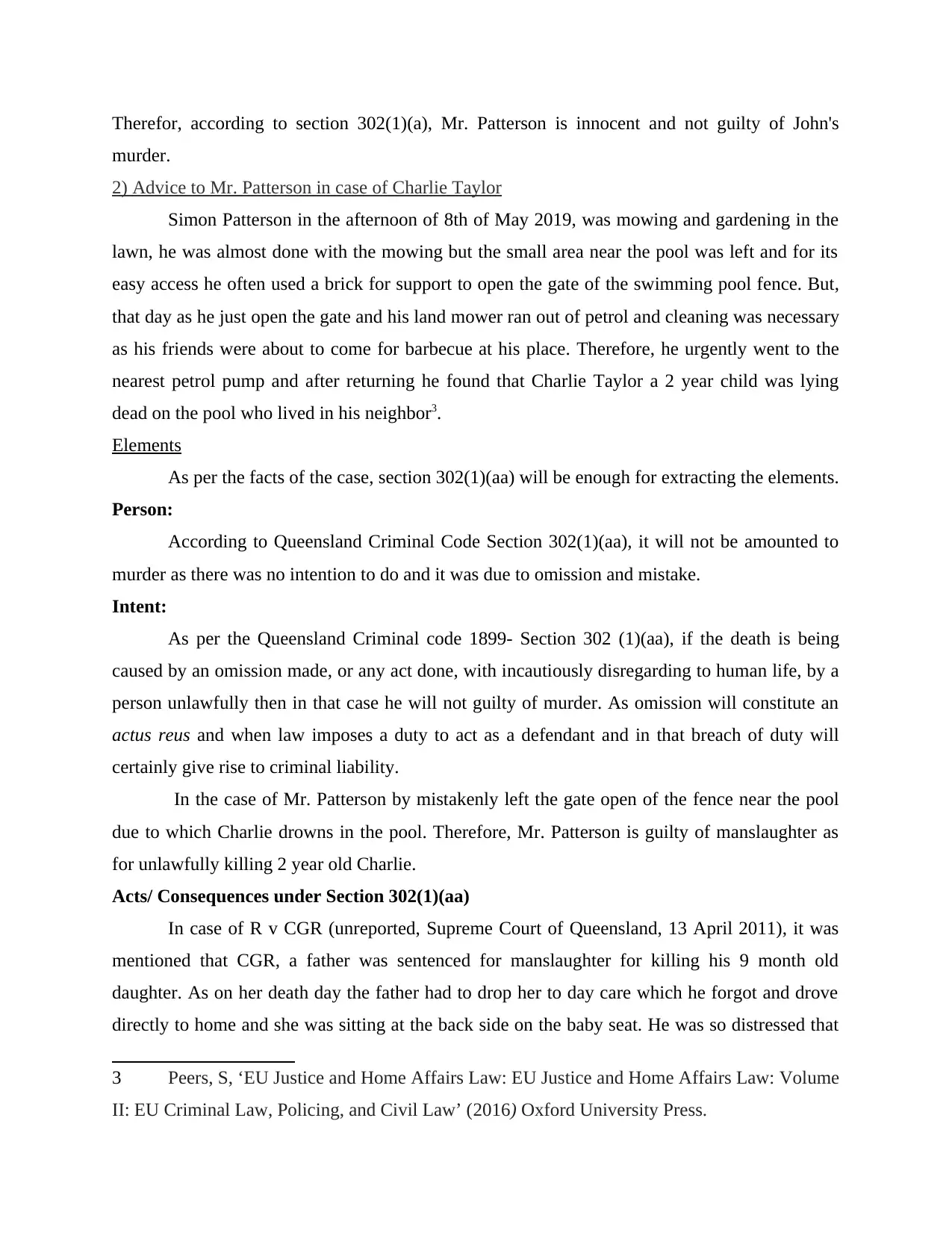
Therefor, according to section 302(1)(a), Mr. Patterson is innocent and not guilty of John's
murder.
2) Advice to Mr. Patterson in case of Charlie Taylor
Simon Patterson in the afternoon of 8th of May 2019, was mowing and gardening in the
lawn, he was almost done with the mowing but the small area near the pool was left and for its
easy access he often used a brick for support to open the gate of the swimming pool fence. But,
that day as he just open the gate and his land mower ran out of petrol and cleaning was necessary
as his friends were about to come for barbecue at his place. Therefore, he urgently went to the
nearest petrol pump and after returning he found that Charlie Taylor a 2 year child was lying
dead on the pool who lived in his neighbor3.
Elements
As per the facts of the case, section 302(1)(aa) will be enough for extracting the elements.
Person:
According to Queensland Criminal Code Section 302(1)(aa), it will not be amounted to
murder as there was no intention to do and it was due to omission and mistake.
Intent:
As per the Queensland Criminal code 1899- Section 302 (1)(aa), if the death is being
caused by an omission made, or any act done, with incautiously disregarding to human life, by a
person unlawfully then in that case he will not guilty of murder. As omission will constitute an
actus reus and when law imposes a duty to act as a defendant and in that breach of duty will
certainly give rise to criminal liability.
In the case of Mr. Patterson by mistakenly left the gate open of the fence near the pool
due to which Charlie drowns in the pool. Therefore, Mr. Patterson is guilty of manslaughter as
for unlawfully killing 2 year old Charlie.
Acts/ Consequences under Section 302(1)(aa)
In case of R v CGR (unreported, Supreme Court of Queensland, 13 April 2011), it was
mentioned that CGR, a father was sentenced for manslaughter for killing his 9 month old
daughter. As on her death day the father had to drop her to day care which he forgot and drove
directly to home and she was sitting at the back side on the baby seat. He was so distressed that
3 Peers, S, ‘EU Justice and Home Affairs Law: EU Justice and Home Affairs Law: Volume
II: EU Criminal Law, Policing, and Civil Law’ (2016) Oxford University Press.
murder.
2) Advice to Mr. Patterson in case of Charlie Taylor
Simon Patterson in the afternoon of 8th of May 2019, was mowing and gardening in the
lawn, he was almost done with the mowing but the small area near the pool was left and for its
easy access he often used a brick for support to open the gate of the swimming pool fence. But,
that day as he just open the gate and his land mower ran out of petrol and cleaning was necessary
as his friends were about to come for barbecue at his place. Therefore, he urgently went to the
nearest petrol pump and after returning he found that Charlie Taylor a 2 year child was lying
dead on the pool who lived in his neighbor3.
Elements
As per the facts of the case, section 302(1)(aa) will be enough for extracting the elements.
Person:
According to Queensland Criminal Code Section 302(1)(aa), it will not be amounted to
murder as there was no intention to do and it was due to omission and mistake.
Intent:
As per the Queensland Criminal code 1899- Section 302 (1)(aa), if the death is being
caused by an omission made, or any act done, with incautiously disregarding to human life, by a
person unlawfully then in that case he will not guilty of murder. As omission will constitute an
actus reus and when law imposes a duty to act as a defendant and in that breach of duty will
certainly give rise to criminal liability.
In the case of Mr. Patterson by mistakenly left the gate open of the fence near the pool
due to which Charlie drowns in the pool. Therefore, Mr. Patterson is guilty of manslaughter as
for unlawfully killing 2 year old Charlie.
Acts/ Consequences under Section 302(1)(aa)
In case of R v CGR (unreported, Supreme Court of Queensland, 13 April 2011), it was
mentioned that CGR, a father was sentenced for manslaughter for killing his 9 month old
daughter. As on her death day the father had to drop her to day care which he forgot and drove
directly to home and she was sitting at the back side on the baby seat. He was so distressed that
3 Peers, S, ‘EU Justice and Home Affairs Law: EU Justice and Home Affairs Law: Volume
II: EU Criminal Law, Policing, and Civil Law’ (2016) Oxford University Press.
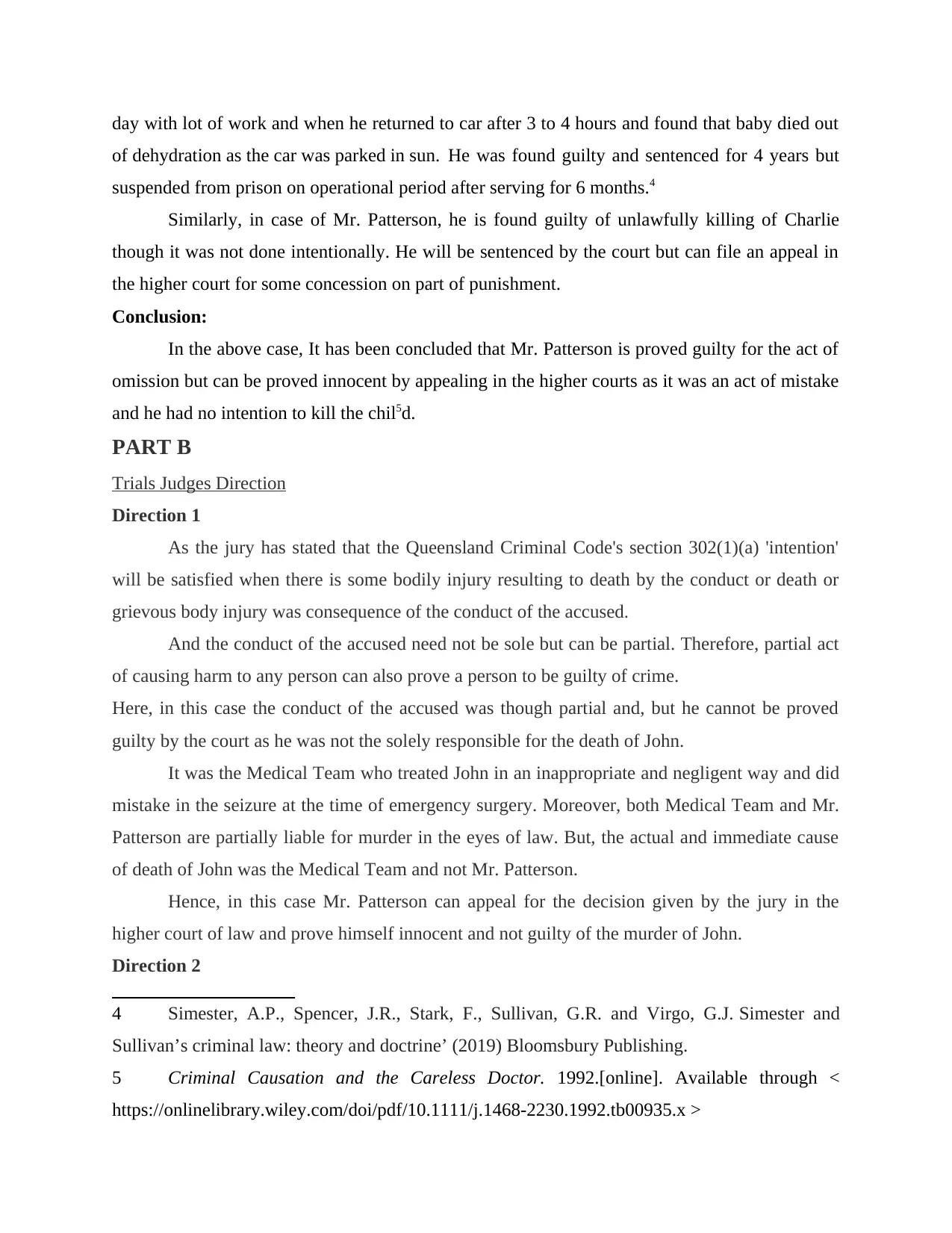
day with lot of work and when he returned to car after 3 to 4 hours and found that baby died out
of dehydration as the car was parked in sun. He was found guilty and sentenced for 4 years but
suspended from prison on operational period after serving for 6 months.4
Similarly, in case of Mr. Patterson, he is found guilty of unlawfully killing of Charlie
though it was not done intentionally. He will be sentenced by the court but can file an appeal in
the higher court for some concession on part of punishment.
Conclusion:
In the above case, It has been concluded that Mr. Patterson is proved guilty for the act of
omission but can be proved innocent by appealing in the higher courts as it was an act of mistake
and he had no intention to kill the chil5d.
PART B
Trials Judges Direction
Direction 1
As the jury has stated that the Queensland Criminal Code's section 302(1)(a) 'intention'
will be satisfied when there is some bodily injury resulting to death by the conduct or death or
grievous body injury was consequence of the conduct of the accused.
And the conduct of the accused need not be sole but can be partial. Therefore, partial act
of causing harm to any person can also prove a person to be guilty of crime.
Here, in this case the conduct of the accused was though partial and, but he cannot be proved
guilty by the court as he was not the solely responsible for the death of John.
It was the Medical Team who treated John in an inappropriate and negligent way and did
mistake in the seizure at the time of emergency surgery. Moreover, both Medical Team and Mr.
Patterson are partially liable for murder in the eyes of law. But, the actual and immediate cause
of death of John was the Medical Team and not Mr. Patterson.
Hence, in this case Mr. Patterson can appeal for the decision given by the jury in the
higher court of law and prove himself innocent and not guilty of the murder of John.
Direction 2
4 Simester, A.P., Spencer, J.R., Stark, F., Sullivan, G.R. and Virgo, G.J. Simester and
Sullivan’s criminal law: theory and doctrine’ (2019) Bloomsbury Publishing.
5 Criminal Causation and the Careless Doctor. 1992.[online]. Available through <
https://onlinelibrary.wiley.com/doi/pdf/10.1111/j.1468-2230.1992.tb00935.x >
of dehydration as the car was parked in sun. He was found guilty and sentenced for 4 years but
suspended from prison on operational period after serving for 6 months.4
Similarly, in case of Mr. Patterson, he is found guilty of unlawfully killing of Charlie
though it was not done intentionally. He will be sentenced by the court but can file an appeal in
the higher court for some concession on part of punishment.
Conclusion:
In the above case, It has been concluded that Mr. Patterson is proved guilty for the act of
omission but can be proved innocent by appealing in the higher courts as it was an act of mistake
and he had no intention to kill the chil5d.
PART B
Trials Judges Direction
Direction 1
As the jury has stated that the Queensland Criminal Code's section 302(1)(a) 'intention'
will be satisfied when there is some bodily injury resulting to death by the conduct or death or
grievous body injury was consequence of the conduct of the accused.
And the conduct of the accused need not be sole but can be partial. Therefore, partial act
of causing harm to any person can also prove a person to be guilty of crime.
Here, in this case the conduct of the accused was though partial and, but he cannot be proved
guilty by the court as he was not the solely responsible for the death of John.
It was the Medical Team who treated John in an inappropriate and negligent way and did
mistake in the seizure at the time of emergency surgery. Moreover, both Medical Team and Mr.
Patterson are partially liable for murder in the eyes of law. But, the actual and immediate cause
of death of John was the Medical Team and not Mr. Patterson.
Hence, in this case Mr. Patterson can appeal for the decision given by the jury in the
higher court of law and prove himself innocent and not guilty of the murder of John.
Direction 2
4 Simester, A.P., Spencer, J.R., Stark, F., Sullivan, G.R. and Virgo, G.J. Simester and
Sullivan’s criminal law: theory and doctrine’ (2019) Bloomsbury Publishing.
5 Criminal Causation and the Careless Doctor. 1992.[online]. Available through <
https://onlinelibrary.wiley.com/doi/pdf/10.1111/j.1468-2230.1992.tb00935.x >
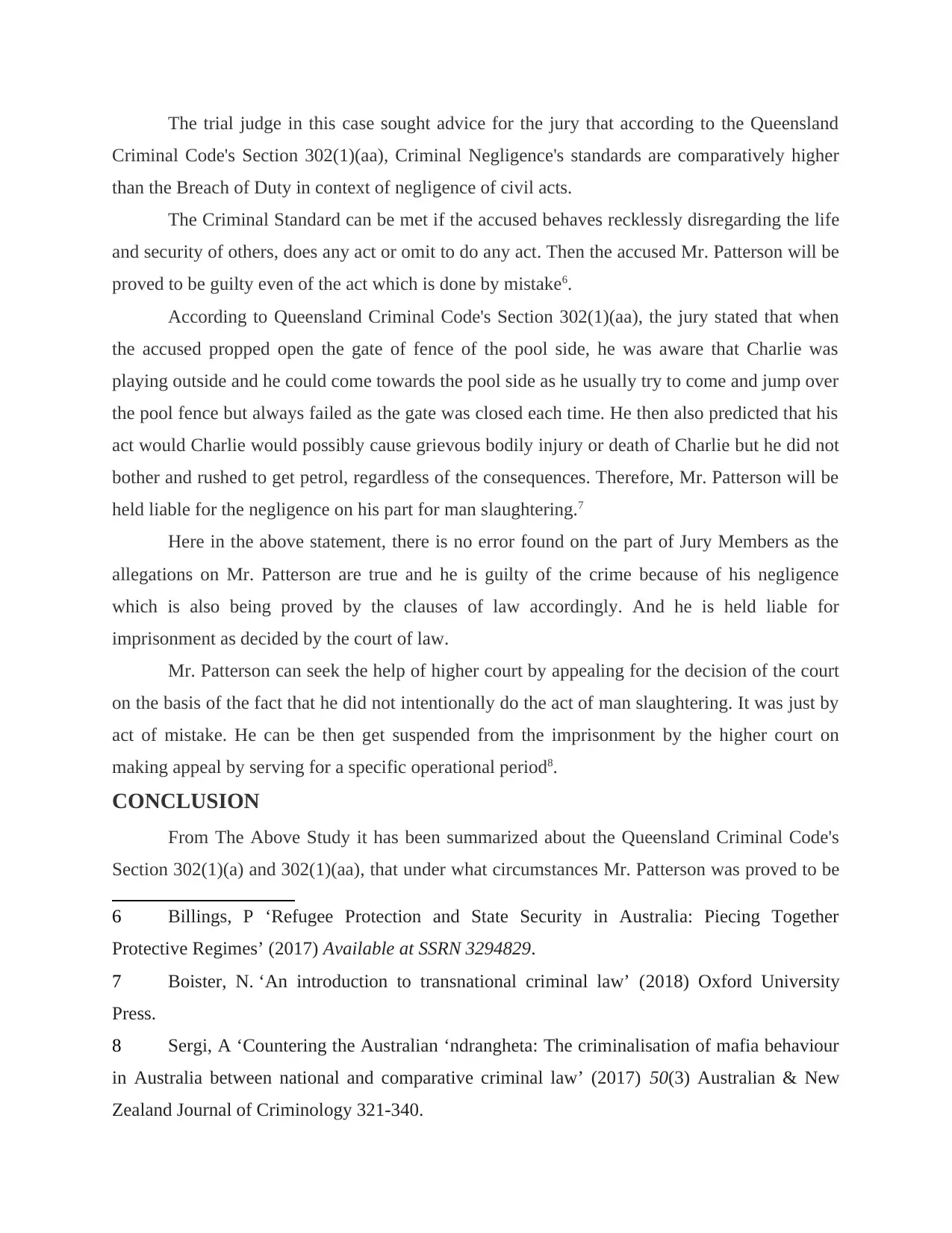
The trial judge in this case sought advice for the jury that according to the Queensland
Criminal Code's Section 302(1)(aa), Criminal Negligence's standards are comparatively higher
than the Breach of Duty in context of negligence of civil acts.
The Criminal Standard can be met if the accused behaves recklessly disregarding the life
and security of others, does any act or omit to do any act. Then the accused Mr. Patterson will be
proved to be guilty even of the act which is done by mistake6.
According to Queensland Criminal Code's Section 302(1)(aa), the jury stated that when
the accused propped open the gate of fence of the pool side, he was aware that Charlie was
playing outside and he could come towards the pool side as he usually try to come and jump over
the pool fence but always failed as the gate was closed each time. He then also predicted that his
act would Charlie would possibly cause grievous bodily injury or death of Charlie but he did not
bother and rushed to get petrol, regardless of the consequences. Therefore, Mr. Patterson will be
held liable for the negligence on his part for man slaughtering.7
Here in the above statement, there is no error found on the part of Jury Members as the
allegations on Mr. Patterson are true and he is guilty of the crime because of his negligence
which is also being proved by the clauses of law accordingly. And he is held liable for
imprisonment as decided by the court of law.
Mr. Patterson can seek the help of higher court by appealing for the decision of the court
on the basis of the fact that he did not intentionally do the act of man slaughtering. It was just by
act of mistake. He can be then get suspended from the imprisonment by the higher court on
making appeal by serving for a specific operational period8.
CONCLUSION
From The Above Study it has been summarized about the Queensland Criminal Code's
Section 302(1)(a) and 302(1)(aa), that under what circumstances Mr. Patterson was proved to be
6 Billings, P ‘Refugee Protection and State Security in Australia: Piecing Together
Protective Regimes’ (2017) Available at SSRN 3294829.
7 Boister, N. ‘An introduction to transnational criminal law’ (2018) Oxford University
Press.
8 Sergi, A ‘Countering the Australian ‘ndrangheta: The criminalisation of mafia behaviour
in Australia between national and comparative criminal law’ (2017) 50(3) Australian & New
Zealand Journal of Criminology 321-340.
Criminal Code's Section 302(1)(aa), Criminal Negligence's standards are comparatively higher
than the Breach of Duty in context of negligence of civil acts.
The Criminal Standard can be met if the accused behaves recklessly disregarding the life
and security of others, does any act or omit to do any act. Then the accused Mr. Patterson will be
proved to be guilty even of the act which is done by mistake6.
According to Queensland Criminal Code's Section 302(1)(aa), the jury stated that when
the accused propped open the gate of fence of the pool side, he was aware that Charlie was
playing outside and he could come towards the pool side as he usually try to come and jump over
the pool fence but always failed as the gate was closed each time. He then also predicted that his
act would Charlie would possibly cause grievous bodily injury or death of Charlie but he did not
bother and rushed to get petrol, regardless of the consequences. Therefore, Mr. Patterson will be
held liable for the negligence on his part for man slaughtering.7
Here in the above statement, there is no error found on the part of Jury Members as the
allegations on Mr. Patterson are true and he is guilty of the crime because of his negligence
which is also being proved by the clauses of law accordingly. And he is held liable for
imprisonment as decided by the court of law.
Mr. Patterson can seek the help of higher court by appealing for the decision of the court
on the basis of the fact that he did not intentionally do the act of man slaughtering. It was just by
act of mistake. He can be then get suspended from the imprisonment by the higher court on
making appeal by serving for a specific operational period8.
CONCLUSION
From The Above Study it has been summarized about the Queensland Criminal Code's
Section 302(1)(a) and 302(1)(aa), that under what circumstances Mr. Patterson was proved to be
6 Billings, P ‘Refugee Protection and State Security in Australia: Piecing Together
Protective Regimes’ (2017) Available at SSRN 3294829.
7 Boister, N. ‘An introduction to transnational criminal law’ (2018) Oxford University
Press.
8 Sergi, A ‘Countering the Australian ‘ndrangheta: The criminalisation of mafia behaviour
in Australia between national and comparative criminal law’ (2017) 50(3) Australian & New
Zealand Journal of Criminology 321-340.
Paraphrase This Document
Need a fresh take? Get an instant paraphrase of this document with our AI Paraphraser

innocent and guilty in case of John's and Charlie's murder. Also various aspects of law are being
mentioned to prove the innocence in case of John and guiltiness in case of Charlie of the accused
Mr. Patterson. Moreover, this report contains the analysis of decision and directions of judges
and advice of jury along with the legal advice to Mr. Patterson for appealing in the higher court
of law accordingly.
mentioned to prove the innocence in case of John and guiltiness in case of Charlie of the accused
Mr. Patterson. Moreover, this report contains the analysis of decision and directions of judges
and advice of jury along with the legal advice to Mr. Patterson for appealing in the higher court
of law accordingly.
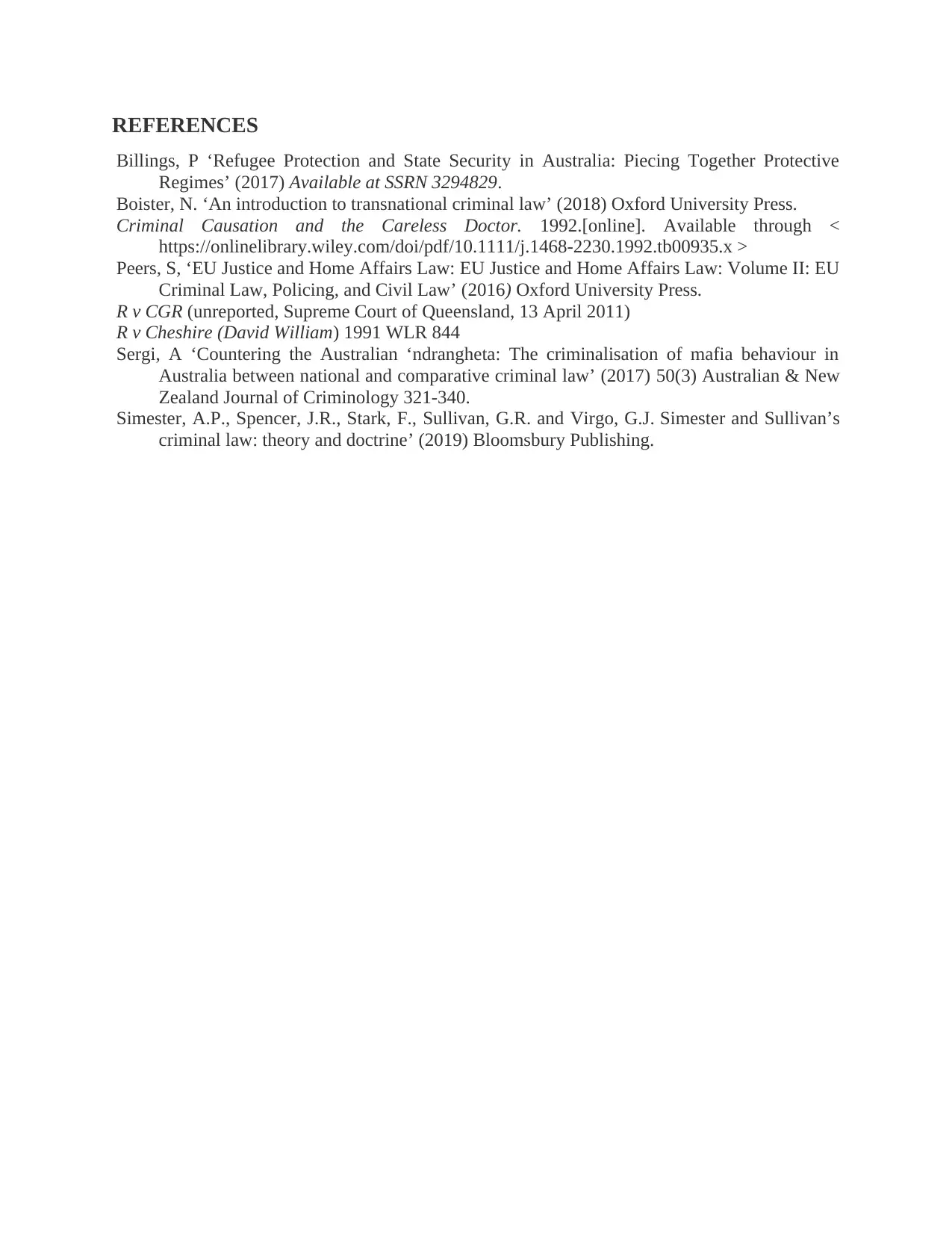
REFERENCES
Billings, P ‘Refugee Protection and State Security in Australia: Piecing Together Protective
Regimes’ (2017) Available at SSRN 3294829.
Boister, N. ‘An introduction to transnational criminal law’ (2018) Oxford University Press.
Criminal Causation and the Careless Doctor. 1992.[online]. Available through <
https://onlinelibrary.wiley.com/doi/pdf/10.1111/j.1468-2230.1992.tb00935.x >
Peers, S, ‘EU Justice and Home Affairs Law: EU Justice and Home Affairs Law: Volume II: EU
Criminal Law, Policing, and Civil Law’ (2016) Oxford University Press.
R v CGR (unreported, Supreme Court of Queensland, 13 April 2011)
R v Cheshire (David William) 1991 WLR 844
Sergi, A ‘Countering the Australian ‘ndrangheta: The criminalisation of mafia behaviour in
Australia between national and comparative criminal law’ (2017) 50(3) Australian & New
Zealand Journal of Criminology 321-340.
Simester, A.P., Spencer, J.R., Stark, F., Sullivan, G.R. and Virgo, G.J. Simester and Sullivan’s
criminal law: theory and doctrine’ (2019) Bloomsbury Publishing.
Billings, P ‘Refugee Protection and State Security in Australia: Piecing Together Protective
Regimes’ (2017) Available at SSRN 3294829.
Boister, N. ‘An introduction to transnational criminal law’ (2018) Oxford University Press.
Criminal Causation and the Careless Doctor. 1992.[online]. Available through <
https://onlinelibrary.wiley.com/doi/pdf/10.1111/j.1468-2230.1992.tb00935.x >
Peers, S, ‘EU Justice and Home Affairs Law: EU Justice and Home Affairs Law: Volume II: EU
Criminal Law, Policing, and Civil Law’ (2016) Oxford University Press.
R v CGR (unreported, Supreme Court of Queensland, 13 April 2011)
R v Cheshire (David William) 1991 WLR 844
Sergi, A ‘Countering the Australian ‘ndrangheta: The criminalisation of mafia behaviour in
Australia between national and comparative criminal law’ (2017) 50(3) Australian & New
Zealand Journal of Criminology 321-340.
Simester, A.P., Spencer, J.R., Stark, F., Sullivan, G.R. and Virgo, G.J. Simester and Sullivan’s
criminal law: theory and doctrine’ (2019) Bloomsbury Publishing.
1 out of 9
Your All-in-One AI-Powered Toolkit for Academic Success.
+13062052269
info@desklib.com
Available 24*7 on WhatsApp / Email
![[object Object]](/_next/static/media/star-bottom.7253800d.svg)
Unlock your academic potential
© 2024 | Zucol Services PVT LTD | All rights reserved.


